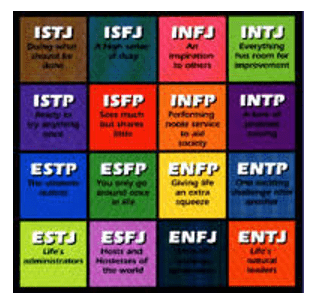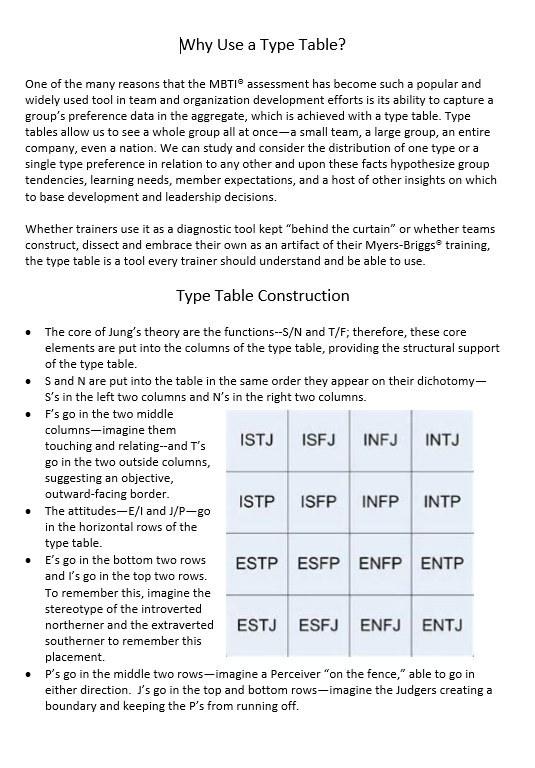Chief among the reasons that the MBTI is both so popular and so useful is the fact that a group’s Type data can be captured, studied and communicated through a Type Table. OKA has long put a lot of time and attention in both using and teaching others how to use these amazing training aids. Below are OKA’s top ten uses for an MBTI Type Table.
1. Calculate group Type
Calculating the composite Type of any given group or team allows you to see, understand and engage the collective as a whole group, a single unit.
2. Derive modal Type
 While the group’s composite Type speaks to the majority preferences, the single Type that is most represented in any given group represents the Modal Type. The Modal Type represents a block of people within the group—a sub-set—that will act, move and be motivated the same way. Comparing the Modal and the Group Types can give a group great insight into itself.
While the group’s composite Type speaks to the majority preferences, the single Type that is most represented in any given group represents the Modal Type. The Modal Type represents a block of people within the group—a sub-set—that will act, move and be motivated the same way. Comparing the Modal and the Group Types can give a group great insight into itself.
3. Tailor exercises and a training design to the group
Knowing the distribution of the preferences—how many Es and Is and how many Ss and Ns, et cetera—allows you to select the exercises that best serve the group and illustrate Type in action.
4. Compare the leader to the group as a whole
Type Tables allow groups and leaders to examine, reflect upon, and discuss the behaviors, preferences and needs of both the leaders and the team as a whole. In what way will leading this team be easy for the leader, and in what way will both the leader and the team’s members be challenged? Analyzing a group’s Type Table will help answer these questions.
5. Predict a team’s communication and learning styles
Just like an individual’s Type preferences suggest his/her learning and communication styles, a group’s Type—reflected through their Type Table—suggests the way the group is likely going to want and share information, make decisions and interact with each other.
6. Identify the behavioral tendencies of the group—what they are likely to look and sound like
In addition to the eight preferences alone—E, I, S, N, T, F, J and P—the Type Table offers a number of preference pairs that speak to likely behaviors. Quadrants—IS, ES, IN and EN; temperaments—NF, NT, SJ and SP; attitude pairs—EJ, IJ, EN and IN. There are 24 two-letter combinations that each suggest a specific pattern of predictable behavior. The Type Table gives you insight into and access to all of these data for any group.
7. Identify activities and behaviors with which the group will likely struggle
The same lenses (two-letter combinations) that highlight probable behaviors and strengths also suggest the behavioral deficits and challenges that any given group will likely have.
8. Present the Type Table as an artifact from the Type training that allows Type to continue to be front-and-center and an ongoing conversation
Impactful, successful training has lasting effects on the groups who engage it, and a Type Table—left behind as a reminder, a summary, and an artifact of the group’s insights and work—can be a tremendous tool to facilitate and even provoke follow-through and next step actions.
9. Distribute the Type Table to all team members as a reference document for each team member to use to remember and use the preferences of colleagues and teammates
Type is most effective when individual leaders, users and learners use its insights to inform and impact relationships—one at a time. Type allows me a model and vocabulary that both enable and encourage me to flex my style to best meet each relationship challenge or situation. (Flexing my Type does not mean my assuming a role or being inauthentic, it means remembering not to be blinded by my preferences and to consider using all parts of myself to best work with the demands life presents me.) Type Tables populated with my colleagues’ validated preferences are tremendous aids in helping me make know what adjustments would be most helpful.
10. Use the Type Table to help you prepare for any group and manage yourself through predictable challenges
The primary gift of Type is greater self-awareness leading to better self-management. How do I manage myself when I (as an Introvert) am expected by an extraverted group to speak, disclose, engage and share more that I would otherwise want to? A group’s Type Table suggests to me what that group will want and expect of me, and—therefore—in what ways I need to self-manage to be successful. 
OKA has prepared a learning guide to help support anyone who wishes to build and use a Type Table. Click here or the image to read or download it.
If you wish to refresh and/or sharpen your MBTI training/ delivery skills, come to OKA’s Type Trainer’s Skillshop. In this fast-paced, two-day training:
- Review the structure and details of Type theory as well as best practices in its delivery
- Explore a number of experiential Type exercises and the best ways to set them up and process the data that flow from them
- Explore ways to customize your training for individuals, teams and organizations—making your approach to Type relevant, practical and actionable
- Learn how to contract for effective, profitable work
- Practice OKA’s approach to Type table analysis and how to adapt training designs to specific groups
- Receive a binder of detailed procedures and training support materials for the set-up, facilitation and debrief of dozens of Type training variations
Click here for more information on or to register for one of OKA’s advanced Type/MBTI workshops.

Leave a Comment